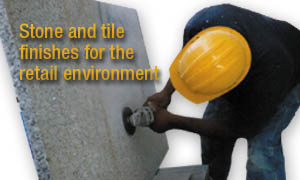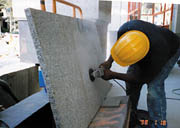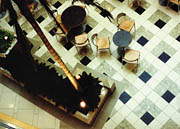
Stone and tile are becoming incredibly popular choices for surfacing finishes in today's shopping malls. In addition to the extensive variety of colors, textures and sizes available, owners and specifiers demand the durability and low maintenance that these finishes provide. Stone and tile are attractive workhorses, offering exquisite looks plus rugged performance. When properly installed and maintained, stone and tile will keep their good looks for many years of service, even under the most trying, heavy-traffic conditions.
The phrase "when properly installed" brings up an important point; the ability of these finishes to perform over the long term is related to the quality of the installation systems and to the installer's skills. The purpose of this article is to discuss the former item and leave the installer issue for another day.
What installation system should be specified, and what ultimately gets used? Do I want the least expensive? What do I really get for my money? What is the reputation of the manufacturer; does the company provide a guarantee? There are a myriad of questions and concerns, with many people ultimately throwing up their hands and stating, "Hey, it's all the same stuff, some Portland cement, sand and some other whiffle dust." But with that mindset, an end user may not get the performance that is expected. Nothing is worse than having sections of flooring coming loose, or cracks developing in the tile, or grout joints looking like they were saturated with diesel oil. So, it is best to try and understand installation systems from the bottom up.

The other substrate condition to consider is cracking. Random cracks often develop in new concrete. They may be caused by shrinkage in the concrete, or may be structural. (Structural cracks must be isolated. Generally A/F membranes are not guaranteed for structural movement cracks. Consult with manufacturer for specific treatments of structural cracks.) In either case, these cracks can telegraph up through the tile finish, and therefore should never be covered over directly by tile. Special membranes have been developed to reduce the potential for cracked tiles. Referred to as anti-fracture or crack suppression membranes, they provide stress relief for substrate cracks. It is important for these anti-fracture membranes to be thin and load bearing. They must be able to handle the heavy-traffic loads that are continually running over the floor (load bearing). They must be thin to accommodate the thin bed method of installation.
The next level to discuss is the bonding system, which holds the tile or stone to the substrate. The most commonly used product is referred to as thinset mortar, a Portland cement-based product. There are many types and categories of thinset mortars available. Recommended for commercial applications such as shopping malls are Latex Portland Cement Mortars, meeting ANSI specification A118.4-1999. Be aware that within this category, there is a wide range of performance differences. Important performance characteristics include shear bond strength, especially bond to the type of tile being installed. Equally important is the reputation and track record of the manufacturer; remember that this bonding system is what is keeping the tile finish in place. The difference between the best system and the cheapest is generally pennies per square foot, it is important to select a system carefully.
There are some special bonding systems to consider as well. Many retail stores, especially jewelry shops, opt for the elegant look of green marble. Many types of green marble are water sensitive; meaning they will curl when installed with water-based thinset mortars. Since all cement thinset mortars are water based, moisture sensitive marbles must be installed in a non-water-based adhesive, such as epoxy adhesive. Today's epoxy adhesives are safe, easy to use, and they stop water-sensitive marbles from curling.
Another special bonding system to consider is rapid set thinset mortar. In general, the thinset mortars noted above require a 24-hour or more restriction on "time to foot traffic." If an application requires a faster time to foot traffic (such as overnight repairs or remodeling) rapid setting thinset mortar is recommended.

Epoxy grouts address many of the limitations of Portland cement grouts. They have low absorption, less than 0.5% (about the same as porcelain and granite tiles), making them highly stain resistant. Additionally, they provide uniform, permanent color. They generally perform as well as the tile. One downside of epoxy grout is price; it can add $1 or more per square foot in terms of cost. The epoxy grout joint, however, will far outperform the Portland cement grout, and in many cases the tile itself.
Another interesting application for epoxies is bonding stone slabs and large-format tiles on walls. Because of their tremendous strength and the ability to bond to a wide range of surfaces, epoxies can hold heavy stone slabs permanently. Older methods of adhering stone, such as with the hook-and-anchor method, have been surpassed by a faster method that involves less breakage or damage to the stone.
Whatever your finish selection is: granite, marble, limestone, porcelain or glazed tiles, take some time to consider your installation system. Look for single source responsibility. Use a single manufacturer with a strong reputation for service and technical support. This will ensure that you get the best installation possible. The installation system makes up a small portion of the total installation package cost that includes: labor + tile finish + installation system. With a marginal system, you get cracked or broken tiles and an unsightly installation, which ultimately results in more expense.
With the right installation system, you get an attractive finish that lasts. And those good looks will ultimately attract customers to a retail environment.